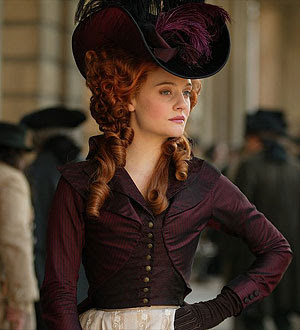I ish sick, blick! But in the middle of everything, and before I loose all brain power dew to my pounding headache, I shall post my latest inspiration.
Continuing on the wave of Victorian, I’d like to introduce Lolita fashion. Most western audiences may be turned off by the name Lolita, images of the novel ‘Lolita’ by Vladimir Nabokov coming to mind. But in a fashion context, is it accpeted that the term dose not relate to the under aged girl in the novel, or movies.
Lolita fashion found it’s popularity in the 1980’s. Unlike other japanese street fashions, the term Lolita is used to refer to a very specific style of clothing. Victorian or Rococo in nature, Lolita fashion attempts to look elegant and cute by using clothing of a childlike nature. The term Lolita is also to some a life style. No, not the falling in love with much older men (which has nothing to do with fashion) but a life style in where one tries to surround themselves with beautiful things, engaging in lady like activities such as baking and embroidery.
So you want to dress in Lolita style, first is to pick what style suits you best. Although there are many different sub-genres, we will focus on just a few. First, my alter ego, Gothic Lolita.
Far from what some envision as gothic (your local high schooler in chains and black lips stick who seems to generally hate the world) Gothic Lolita is far from it, clade in sweet black numbers that take inspiration from Victorian clothing; lace, button up boots, and sweet makeup. Looking for inspiration for your GothicLoli clothing, fly over to Tokyo, and visit Harajuku on the weekend. (I was very sad during my stay in Japan that I ran out of time, and thus was not able to see Harajuku.) There is a purple and black lace/tool skirt in my dresser that keeps calling me to go back. Ahh, if only I lived in a Japan. My alter ego would take over and we’d go dancing around Harajuku in the best black lace dress and big parasol I could find. But, maybe Gothic Lolita is not your thing, want something more, well….less black?
Find your inner princess, as we dance through fields of rainbows, pink buttons and long blond hair. Meet Sweet Lolita, one of the more outgoing styles in Lolita fashion. Pastel colors fill the wardrobe of a Sweet Lolita style. The use of toys is also common, such as cakes, candies and hearts. Probably the closest to a childlike image out of all the different Lolita styles. So, have visions of sipping tea in the backyard with your own host of cute little side kicks, or want to find your inner little girl who sleeps in her pink shoes, then you my friend have found your life long match.
But…….maybe your having seconds thoughts. Your inner child is suddenly reminded of the numerous things she wasn’t tall enough to do, or the scolding she got when she decided to paint on the wall. No worries.

Konda, or Ouji (spell check is not liking my japanese words) Ouji (meaning prince) gathers reference from the clothing of little boys during the Victorian period; still sticking with the childlike image. This style can be lade back or very over the top. Ouji, unlike Sweet Lolita, is both a male and female style, although men normally reefer to themselves as ‘Dandy’s’.
Very common are the ‘prince pants’ or knee breeches, along with
hats, canes, vest, capes, ties, and cravats. Although Ouji (Konda is the western name) can be a category all on it’s own, it still holds place in the theme of Lolita. Wanting to be grown up and young at the same time, or wanting to be manly and still ware lace, then let Ouji Lolita be your new best friend.
Still haven’t found one that tickles your taste buds, try checking out Punk, Sailor, Wa, or Shiro Lolita. No matter your taste, Lolita fashion is sure to inspire something that lives inside your creative mind.
Looking for a history lesson info on Lolita fashion, check out. http://www.lolitafashion.org/
#Historical fact: Although the term “Lolita” Is used in western culture to refer to an underage girl with….certain desires, the word comes from the spanish name Lola, which means sorrow.







